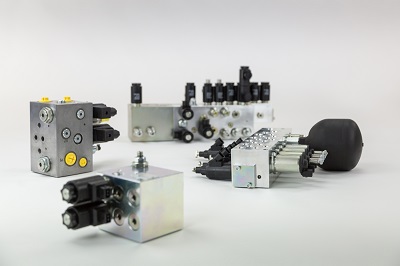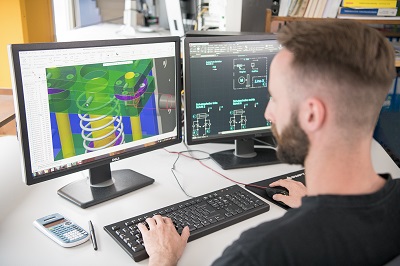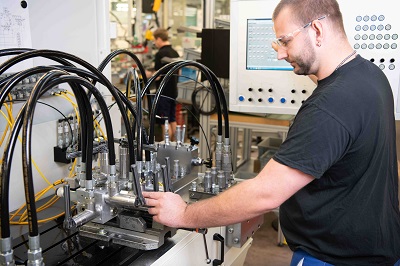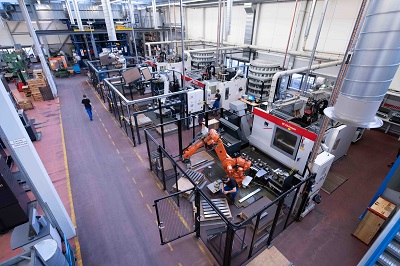By Michael Pyper
Bucher Hydraulics
High hydraulic performance is crucial in mobile machinery. Especially in this era of increasing electrification, hydraulics remains vital. This is particularly true for agricultural and forestry machines where compact installation and weight optimization are essential. Fluid power plays a significant role in energy efficiency and, when intelligently combined, electric and hydraulic drives complement each other well.

Keys to efficiency
Despite the rise in electrification, nearly all mobile sectors rely on the power of hydraulics. However, hydraulics often suffers from a perception of inefficiency. This isn’t a technical failing but, rather, historically established priorities: high power density, reliability, durability, and, of course, cost pressures. But hydraulics can indeed be efficient. Minimized pressure drops and streamlined designs allow for smaller batteries in electrified machines, saving both weight and cost.
Bernhard Zbären, director of sales and project engineering of control blocks at Bucher’s Frutigen, Switzerland location, sees electrification as an ally of hydraulics, not an opponent. “In agriculture, you can’t just send one battery pack after another across a field. Besides the cost, the pressure on the soil from such an immense weight would be an almost insurmountable problem,” he said.
It’s essential to cut unnecessary energy consumption, he noted. In particular, hydraulic control blocks can unnecessarily consume a lot of energy if improperly designed. Meeting today’s challenges demands extensive engineering know-how. In addition, however, Bucher Hydraulics also focuses on a customer-centric approach, an educated workforce, and highly automated manufacturing to ensure long-term success, said Zbären.

Long-term relationships
While large OEMs and customers usually handle the design and optimization of their systems in-house, medium and small manufacturers count on extensive expertise and services from their hydraulic partner, necessitating close collaboration. Bucher Hydraulics meets these ever-growing demands through decades of product and application experience and combines this knowledge with extensive expertise in production techniques of system solutions.
A key aspect in finding the best solution is establishing a direct customer relationship managed by a single individual responsible for both technical and sales aspects. Zbären’s department handles both project planning and sales. And comprehensive project management allows customers flexibility in their level of involvement, ranging from initial contact to prototype implementation, on-site commissioning, post-sale support, and even product phase-out.
Project development for control blocks includes material and bore selection, connections, and valve layout of the selected cartridge valves — documented as a circuit diagram, a 3D model, and a technical drawing. On the commercial side, the team discusses desired services, target price agreements and the project’s timeline with the customer.
Additionally, the project team handles the ramp-up phase of pilot or production runs, forecasting, after-sales service, documentation, and product phase-out. Having a single point of contact for often long-term customers over years leads to good customer relationships, mutual understanding, and quick response times.
Training is essential
Well-trained employees are the foundation of such an organization. In Frutigen, almost all employees have undergone the proven Swiss dual-education system. It combines theory and practice in a three or four-year apprenticeship, followed by further training and internal schooling at all levels: technical as well as administrative and commercial. “It initially takes a lot of time and money, but it’s a worthwhile investment. Well-trained specialists achieve their goals faster, which benefits both our customers and us,” said Zbären.

When designing according to customer specifications and with the help of 3D CAD programs, the aim is to achieve a particularly compact control-block design to meet all weight and dimensional specifications. A crucial aspect: production-related specifications, like machinery and deburring processes, are considered during the design phase because manufacturing is done in-house at Bucher. Design engineers are familiar with the capabilities and requirements of the production equipment, so that automation is already considered in the project planning phase.
The results include the manufacturing and assembly drawings, and the customer spare parts drawings. Speaking of spare parts, they are available for at least ten years after production ends, often even longer. Additionally, customers can integrate 3D CAD models into their own designs.
Prototypes and inspections
Prototypes are also made in-house. Using prototypes, extensive tests can be carried out on test benches specially designed by Bucher lab and automation specialists. This prevents nasty surprises in later series production. Once everything is tested, approved and manufactured, assembly is fully carried out by trained personnel in-house.
Every product undergoes an automatic function and leak test with oil before being shipped to the customer. Pressure and flow-rate adjustments are made on the test bench and, if requested, the valve characteristic curve can be attached as a QR code.

Cutting-edge machining
Bucher Hydraulics’ machining centers allow multi-sided machining with utmost precision, as there are no reclamping operations. To achieve short chip-to-chip times, fully automatic workpiece storage systems, in collaboration with industrial robots, handle loading and unloading. Tool changes, even for small batches, are as streamlined as in mass production. This boosts productivity and flexibility while reducing lead times.
Bucher’s proprietary equipment design ensures that the strengths of each manufacturing machine are fully utilized through its clamping devices, tools, and grippers. And because production know-how is also available to the project managers who design the system control blocks, they can engineer smart solutions with a particular focus on production.
In this way, Bucher Hydraulics provides customers with superior support in the construction of their hydraulic machines. The goal is to deliver a top-tier product that meets all the customer’s requirements. “We are driven to make our clients successful because that’s the only way we can be successful ourselves. Hydraulics will continue to be essential, complementing electrification effectively in the future,” said Zbären.
Bucher Hydraulics
www.bucherhydraulics.com
Filed Under: Components Oil Coolers, Mobile Hydraulic Tips, Technologies, Trending, Valves & Manifolds